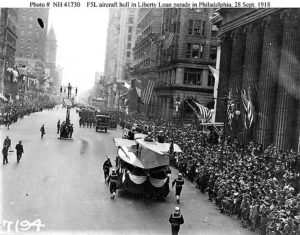On this page we will look back at life in the city during the war years. Here we will provide the visitor with the stories making the news, what was happening in sports and entertainment, city politics, the social scene and the prominent people at the time. So, check back often for new editions. To share your family or neighborhood stories, please email PhillyWWIyears@gmail.com
TODAY IN PHILADELPHIA – SATURDAY SEPTEMBER 28, 1918
The will be clear, bright skies over the city today and tomorrow. Today’s high will be a cool and pleasant 69° with the low tonight near 50°. Over 200,000 people lined Broad Street from Diamond to Mifflin this afternoon to see the spectacular parade which opened the 4th Liberty Loan drive in this city. No one gives a parade like Philadelphia and today was no exception. For this was not just a parade but a moving pageant of sight and sound.
The parade was separated into three divisions. The first featured the military and naval forces. The second represented this city’s factories and shipyards while the third was dedicated to the women involved in charity and relief, heavy labor and on the farms. The parade was led by the mounted police who were then followed by the Marine Band of League Island.
The Military and naval division stepped smartly led by the Navy Yard contingent of 3000 sailors, marines and yeowomen. These fighting men and women stopped at each block and performed military drills to the delight of the crowd. The Navy Yard brought a number of floats but the one that carried a huge flying boat stunned the crowd into shouts of awe. Also with this division came the Boy Scouts, hundreds of them, marching and riding bicycles to represent their service as messengers. In the air a fleet of flying machines soared doing what seemed like impossible maneuvers while anti-aircraft guns blasted away shocking the crowd along the route.

Finally Pershing’s heroes, those wounded in the fight for freedom, were included in this division. Some of the men marched but others had to be driven in automobiles due to the seriousness of their injuries. Every onlooker clapped and cheered for these brave men and when they passed by every man in the crowd removed his hat in respect.
The factory and shipyard division representing all the industries involved in war production came next. Midvale Steel and Ordnance Company marched first and brought an 8-inch howitzer along on a float which all admired. Tacony Ordnance Works, A.H. Fox Gun Company, Baldwin Locomotive and DuPont Powder Company also sent large contingents as did E.G. Budd Company.
The shipyards followed including workers from Hog Island, Cramps, Pusey & Jones, Sun, Chester, Merchant and New York Shipbuilding. The Hog Islanders were dressed in their working attire and included riveters and welders. These were followed by a float carrying a huge wooden keel accompanied by shipwrights.
The Frankford Arsenal came with floats depicting each step in the manufacture of bullets and shells, the work of the chemical laboratory and other departments of the facility. These floats were “manned” by 570 girl workers dressed in their khaki uniforms and overseas caps. Perhaps the hit of the Arsenal’s attractions was the ammunition box on wheels drawn by Frankford’s mascot, a furry little dog.
The women’s division closed the parade. It was led by Girl Scout Troop 43 of Chestnut Hill. The girls “manned” a mock camouflaged tank that shot not shrapnel but toy rubber balls. Next came 2000 Red Cross workers. Each Red Cross unit carried a banner announcing its place of origin. They included Lit Brothers, Snellenburg’s, Gimbel Brothers and Wanamakers as well as every other unit in the city. Finally came the members of the Liberty Loan Committee, followed by the Emergency Aid of Pennsylvania and the “farmerettes” of the Woman’s Land Army.
Between each division and interspersed within them were bands and choirs leading the crowd in patriotic songs. The most popular of which was, of course, “Over There”. Speakers also marched and mingled with the crowd encouraging them to buy Liberty Bonds. They would remind the onlookers that this Liberty Loan campaign was a loan for victory.
There was also poignancy as these speakers would ask if there was anyone there who had lost a son, husband, father, brother or sweetheart in the fight. Too often a woman would meekly raise her hand and the surrounding crowd would affectionately applaud her while other women closest to her would offer a hand or gentle caress on her shoulders. The speaker would then state to the crowd, in a respectful manner, “This woman has given her all. What will you give?”

GET YOUR COPY BY CLICKING HERE: PHILADELPHIA: THE WORLD WAR I YEARS
